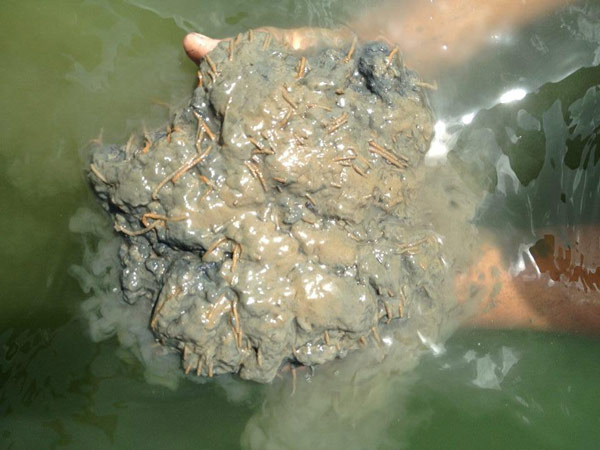Breeding natural food according to Copefloc technology for high productivity
Copefloc uses copepods (copepods), biofloc particles and mollusks live bottom (polychaete worms, .) as a major food source for farmed shrimp and absolutely no use of food. industrial members.
Copefloc technology - technology to feed natural food
In order to raise natural food according to Copefloc technology for high productivity, after taking water into ponds from settling ponds (treated water, sedimentation in settling ponds for a long time) until reaching a depth of 1.2 - 1.5 m, conducting breeding copepods , other species of animal plankton, small crustaceans (krill) and mollusks living in the bottom (barnacle, polychaete, bivalve species, and other animal species soft live other bottom) by using fermented rice bran with probiotics (probiotics).
Absolutely do not supply copepods or other organisms from outside to the pond to prevent them from carrying pathogens into the pond, all natural food species in the system itself will develop when available. the right conditions. Rice bran is put in a large pot, put in pond water and probiotics and has a strong air drop for 24 - 48 hours.

Polychaete worms and molluscs live in the bottom of a pond of copefloc.(Photo: Aquanetviet)
Then add the fermented rice bran mixture into a long cloth bag (similar to a water pump), transfer to the pond and regularly turn the cloth bag so that the probiotic fermented rice bran spread throughout the pond. Ponds are continuously reduced during 7-10 days before stocking shrimp.
Use initial fermented rice bran at a dose of about 300 kg or 30 ppm per hectare to create natural food in the pond. Fermented rice bran will be a food source for copepods, molluscs and other organisms in the pond.
During feeding, there is no need for feeding ; instead farmers must manage, maintain populations and density of natural feed, biofloc in the pond. Collect samples and calculate copepod density daily by using buckets, pots to take 50-100 liters of water at different locations in the pond.

This is a good source of natural nutrition for shrimp.(Photo: Aquanetviet)
Then filter through plankton, 50 - 70 µm mesh size, put into 60 ml vial, fixed by formol 2 - 4%. Pipette 1 ml and count under a microscope at 10X, 40X magnification, by moving the counting chamber by coordinates. Since then calculate the density of copepod and adjust the amount of biological preparations applied to the pond as food for copepods and organisms in the pond.
To stimulate the formation and maintenance of biofloc stability, biofloc primers need to be supplemented and carbon is added to the culture system. There are many sources of carbon: cereal flour, molasses, bagasse, straw, grass. Maintain biofloc content
- Choose to create new rice varieties with high productivity
- High-tech farm model in the UK
- China produces rice varieties higher than human heads for high productivity
- Vietnam is obsolete with genetically modified technology
- Carved crystal of high-fat food
- The method of growing slanted papaya gives outstanding productivity
- Vietnam first tested the electric field technology to preserve food
- ASEAN prioritizes food security and disaster warning
- Discovering a new kind of rice gene for high yield
- Natural foods help cure
- Successfully growing high quality rice varieties from Japan
- Using nylon tanks to improve the productivity of terrestrial eel farming
 'Barefoot engineer' invents a pipeless pump
'Barefoot engineer' invents a pipeless pump Process of handling dead pigs due to disease
Process of handling dead pigs due to disease Radiometer
Radiometer Warp Engine: Technology brings us closer to the speed of light
Warp Engine: Technology brings us closer to the speed of light